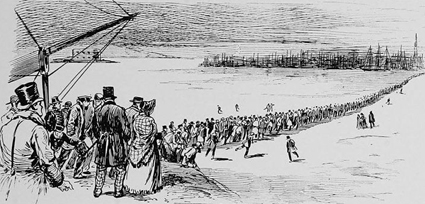On This Day in History, March 19: No More Ice Bridges, Thank You

Ah, springtime. Hello to sunshine and green things growing. Goodbye to darkness and cold and shoveling snow, although we didn’t get too much of that this year.
We’ve just about made it through another winter, and this year made it all the more apparent that our winters are not nearly as harsh as those of our forbears’.
During the 19th century, the East River was regularly rife with enormous chunks of ice that jammed up ferry traffic, leaving freezing passengers stuck out in the middle of the harbor for hours on end. Until 1883, there was no Brooklyn Bridge to carry people over to Manhattan. In fact, the ice floes in the river were a chief reason that people called for the construction of a bridge, so that commerce would not freeze along with the water.